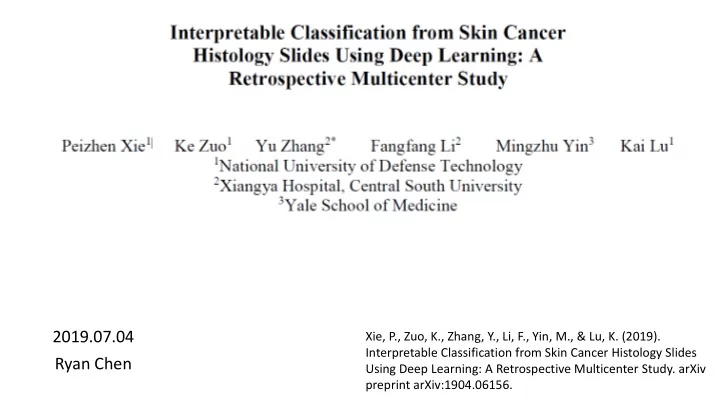

2019.07.04 Xie, P., Zuo, K., Zhang, Y., Li, F., Yin, M., & Lu, K. (2019). Interpretable Classification from Skin Cancer Histology Slides Ryan Chen Using Deep Learning: A Retrospective Multicenter Study. arXiv preprint arXiv:1904.06156.
Introduction • hematoxylin and eosin (H&E) stained tissue sections remains the gold standard in diagnosing melanoma. • we investigated whether deep convolutional neural networks can extract structural features of complex tissues directly from these massive size images in a patched way. • the visualization of CNN representations is furthermore used to identify cells between melanoma and nevi.
Main contributions 1. The first time used the visualization of CNN representations to distinguish between melanoma cells and nevus cells, and then to accurately locate ROI, which are helpful for assisting doctors in diagnosis. 2. We demonstrate classification of skin diseases using both ResNet50 and Vgg19 by transfer learning mechanisms, using only pixels and disease labels as inputs. 3. Extensive experiments simulating the clinical diagnosis process are conducted to evaluate the effectiveness.
Database • a multicenter database of 2241 digital whole-slide images from 1321 patients from 2008 to 2018. • diseases which are melanoma (MM), intradermal nevus (IN), compound nevus (CN) and junctional nevus (JN) respectively. • contain 8350 tissues, and each labeled tissue is made into over 9.95 million patches with size 256 × 256 in four different magnifications • 4X(5 microns/pixel), 10X (1 microns/pixel), 20X(0.5 microns/pixel) and 40X (0.275 microns/pixel).
melanoma
Methodology • ResNet50 and Vgg19 using over 9.95 million patches by transferring learning • ground truth was obtained via manual delineation of the tissue region by 10 dermatologists and 20 pathologists. • From the data with ground truth, we split 70% data as training set, 15% as the validation set, and 15% as testing set. • explanations of individual network decisions have been explored by generating informative heatmaps such as CAM and grad-CAM.
Task 1. melanoma classification from nevi in four different magnifications 2. melanoma classification from each kind of nevus in 40X 3. melanoma classification from nevi in mixed magnifications 4. nevi classifications.
• classification of melanoma from three nevi, which are IN, JN and CN. • 49533 patches from 4X, 104816 patches from 10X, 101070 patches from 20X and 101034 patches from 40X. • best values of each metric are shown in 40X. • ResNet50 are all better than Vgg19.
• In a clinical scenario, pathologists often use images in a manner of mixed magnification for cancer diagnosis. • In this test, patches of each magnification are randomly selected data source to build this dataset. • Data sizes consist 40928 patches of IN, 43430 patches of JN, 48284 patches of CN and 69020 patches from MM.
Heatmaps
Conclusions • Both classic CNNs architectures are applied to take classifications and achieve much better performance than existed studies. • Different cell morphology between melanoma and nevi are illustrated by the visualization of CNN representations and ROI are also located.
Recommend
More recommend